
Orchids are plants that belong to the family Orchidaceae, a diverse and widespread group of flowering plants with blooms that are often colourful and fragrant.

Vanda, abbreviated in the horticultural trade as V., is a genus in the orchid family, Orchidaceae. There are about 87 species, and the genus is commonly cultivated for the marketplace. This genus and its allies are considered to be among the most specifically adapted of all orchids within the Orchidaceae. The genus is highly prized in horticulture for its showy, fragrant, long-lasting, and intensely colorful flowers. Vanda species are widespread across East Asia, Southeast Asia, and New Guinea, with a few species extending into Queensland and some of the islands of the western Pacific.
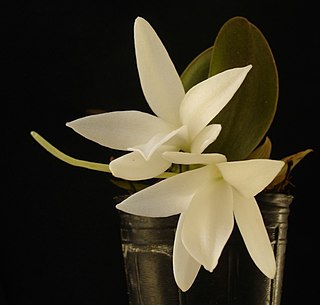
Aerangis, abbreviated as Aergs in horticultural trade, is a genus of the Orchid family (Orchidaceae). The name of this genus has been derived from the Greek words 'aer' (air) and 'angos' (urn), referring to the form of the lip. It is the type genus of the subtribe Aerangidinae, which has recently been subsumed in the subtribe Angraecinae. Approximately 50 species in this genus are known mostly from tropical Africa, but also from the Comoro Islands, Madagascar and Sri Lanka.

Aerides, known commonly as cat's-tail orchids and fox brush orchids, is a genus belonging to the orchid family. It is a group of tropical epiphyte orchids that grow mainly in the warm lowlands of tropical Asia from India to southern China to New Guinea. They are valued in horticulture for their racemes of showy, fragrant, colorful flowers.

Calypso is a genus of orchids containing one species, Calypso bulbosa, known as the calypso orchid, fairy slipper or Venus's slipper. It is a perennial member of the orchid family found in undisturbed northern and montane forests. It has a small pink, purple, pinkish-purple, or red flower accented with a white lip, darker purple spottings, and yellow beard. The genus Calypso takes its name from the Greek signifying concealment, as they tend to favor sheltered areas on conifer forest floors. The specific epithet, bulbosa, refers to the bulb-like corms.

Phalaenopsis, also known as moth orchids, is a genus of about seventy species of plants in the family Orchidaceae. Orchids in this genus are monopodial epiphytes or lithophytes with long, coarse roots, short, leafy stems and long-lasting, flat flowers arranged in a flowering stem that often branches near the end. Orchids in this genus are native to India, Taiwan, China, Southeast Asia, New Guinea and Australia with the majority in Indonesia and the Philippines.

Cymbidium, commonly known as boat orchids, is a genus of evergreen flowering plants in the orchid family Orchidaceae. Orchids in this genus are epiphytic, lithophytic, terrestrial or rarely leafless saprophytic herbs usually with pseudobulbs. There are usually between three and twelve leaves arranged in two ranks on each pseudobulb or shoot and lasting for several years. From one to a large number of flowers are arranged on an unbranched flowering stem arising from the base of the pseudobulb. The sepals and petals are all free from and similar to each other. The labellum is significantly different from the other petals and the sepals and has three lobes. There are about fifty-five species and sixteen further natural hybrids occurring in the wild from tropical and subtropical Asia to Australia. Cymbidiums are well known in horticulture and many cultivars have been developed.

Acampe, abbreviated as Acp in horticultural trade, is a genus of monopodial, epiphytic vandaceous species of orchids, distributed from tropical Asia from India, eastwards to China and southwards to Malaysia, and the Philippines as well as from tropical Africa, Madagascar and islands of the Indian Ocean. The name Acampe was derived from the Greek word akampas, meaning "rigid", referring to the small, brittle, inflexible flowers.
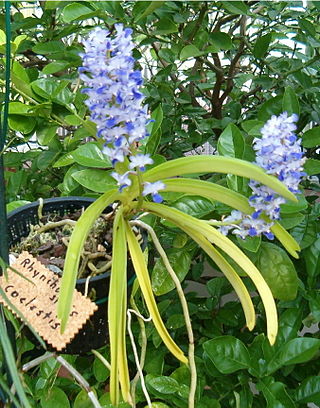
Rhynchostylis is a genus in the orchid family (Orchidaceae), closely allied to the genus Vanda and comprising four currently accepted species native to the Indian Subcontinent, China, Indochina, Malaysia, Indonesia and the Philippines. The name consists of a compound of two Greek elements : rhynchos 'beak' and stylis 'column' – in reference to the very broad, fleshy column of the flower. The flowers are borne in dense racemes and are noted for their intense, spicy fragrance. Although lacking in pseudobulbs, the plants have leathery leaves that are drought-resistant. These orchids grow naturally in warm, moist, shaded tropical areas and will thrive in cultivation if given consistent warmth, uniform moisture and bright, but indirect light. Hobbyists wanting to grow them will need a warm, humid growing environment with gentle air movement. They can be grown in pots, but are better grown in baskets, owing to the extreme fleshiness of their roots. Their unusually fragrant blooms often appear in the slightly cooler winter months.
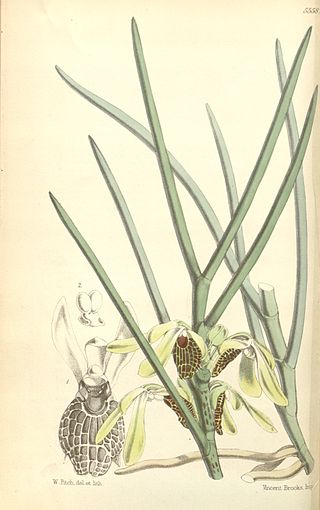
Luisia, commonly known as velvet orchids or 钗子股属 , is a genus of epiphytic or lithophytic orchids in family Orchidaceae. Plants in this genus have flattened roots, long leafy stems, narrow, thick, leathery leaves and short-lived flowers that open sporadically. There are about forty species found from tropical and subtropical Asia to the Western Pacific.

Trichoglottis, commonly known as cherub orchids or 毛舌兰属 , is a genus of flowering plants in the family Orchidaceae. Orchids in this genus are epiphytic plants with thick roots, relatively thick, fibrous stems and many large, thick, leathery leaves arranged in two ranks. The flowers are usually small and yellowish with light brown or purple markings. The flowers have broad sepals, narrower petals and a labellum which has three lobes and is often hairy. There are about 85 species distributed from tropical and subtropical Asia to the north-western Pacific. Most species grow in rainforest.

Vanda miniata, the rust-red ascocentrum, is a species of orchid found in Assam, Laos, Thailand, Vietnam, Java, Malaysia, Philippines, Sumatra. It was formerly known as Ascocentrum miniatum and was the type species of the genus Ascocentrum, now synonymous with Vanda.
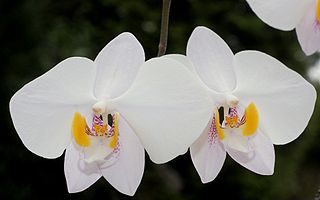
Phalaenopsis philippinensis is an endemic species of orchid found from Luzon island in the Philippines.

Vanda cristata is a species of orchid found growing in the Himalaya from Bangladesh, India, Nepal, Bhutan to China at elevations of 600 – 2300 meters.

Vanda tessellata is a species of orchid occurring from the Indian subcontinent to Indochina. It is a medicinal plant.
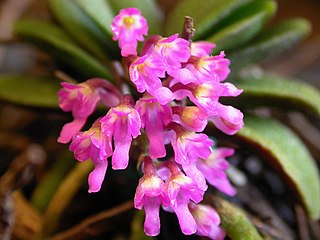
Schoenorchis, commonly known as flea orchids, or 匙唇兰属 in Chinese, is a genus of flowering plants from the orchid family, Orchidaceae. Plants in this genus are small epiphytes with thin roots, thin leafy stems with leaves in two ranks and tiny fragrant, almost tube-shaped flowers with a prominently spurred labellum. There are about twenty five species found from tropical and subtropical Asia to the Western Pacific.

Vanda falcata, also known as 风兰 in Chinese, 풍란 (pungnan) in Korean, 風蘭 (fūran) in Japanese, or the wind orchid in English, is a species of orchid found in China, Korea, and Japan. It was formerly classified in the genus Neofinetia.
Caladenia lateritica, also known as white primrose orchid, is a plant in the orchid family Orchidaceae and is endemic to relatively inaccessible, high lateritic plateaux in a high rainfall area in south-western Western Australia. It is a ground orchid with a single hairy leaf and one or two white flowers on a thin, sparsely-hairy stem. It is similar to Caladenia flava but is distinguished by its fragrant white versus yellow flowers with prominent red stripes and spots on the dorsal sepal and lateral petals. Caladenia lateritica mimics Conostylis setosa (Haemodoraceae) in terms of flowering time, height, colour and fragrance. It also shares a native bee pollinator with Conostylis setosa, which provides pollen and nectar whereas the orchid is rewardless.

Pelatantheria insectifera is a species of orchid occurring in Thailand, Laos, India. The species is a long-stemmed epiphytic herb. The small flowers have a relatively large, fleshy, bright pink labellum. The specific epithet "insectifera", meaning "insect bearing", refers to the flowers, which are indicated to resemble an insect. Thus, attraction of pollinators by means of sexual deception is implied, but to date no pollinator has been published. The flowers are produced from September to October on subsessile racemes, which are shorter than the leaves. The plants are almost entirely self-incompatible, but a small percentage of self-pollination events may be successful. After pollination the colour of the labellum changes from pink to red and the sepals and petals begin to close.

Vanda dives is a species of epiphytic orchid native to Vietnam and Laos.



















